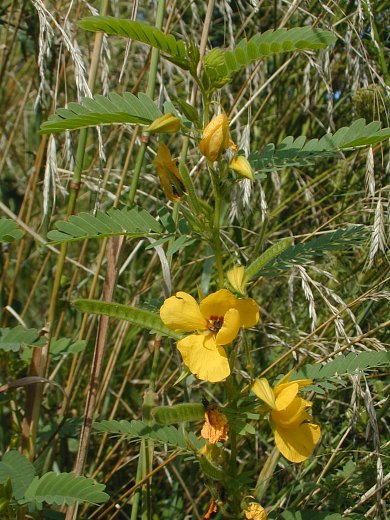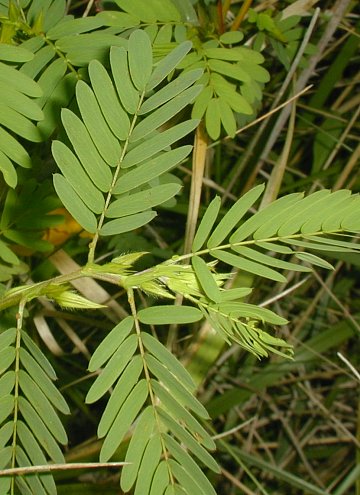Description:
This
annual plant is ½-2' tall, branching occasionally. Shorter
plants are erect, while taller plants are inclined to sprawl. The
slender hairless stems are initially light green, but become reddish
brown. The alternate compound leaves are medium to dark green. They
have petioles with nectaries that attract insects. Each compound leaf
has up to 20 leaflets, which are somewhat sensitive to touch. A leaflet
is about 2/3" long and 1/3" across. It is hairless and oblong. The
bright yellow flowers appear along the major stems near the axils of
the leaves. They are about 1" across, and have an open, irregular
shape. Each flower has 5 rounded petals that vary in relative size, and
there are about 10 reddish stamens. There is no floral scent. The
blooming period is quite long, from mid-summer to fall. During the
fall, pods develop that are initially hairy green, but later become
hairless and dark brown. They are about 2½" long, ¾" across, and rather
flat. The seeds are dark brown, rather flat, and slightly pitted. The
root system consists of a central taproot and smaller auxillary roots.
Cultivation:
The preference is full sun and average to dry conditions. The soil can
contain sand, loam, gravel, or clay, to which this plant will add
nitrogen. It favors poor soil because of reduced competition from other
plants. Partridge Pea is easy to grow, but can spread readily in dry,
open situations. It's not usually bothered by disease.

Range &
Habitat:
The native Partridge Pea is widespread and locally common in Illinois,
except in
some northern counties, where it is uncommon or absent (see Distribution
Map). Habitats include mesic to dry black soil prairies, sand
prairies, savannas, limestone glades, abandoned fields, open areas
along railroads and roadsides. Sometimes Partridge Pea is deliberately
planted to stabilize banks around ditches and other areas, from where
it frequently escapes. This plant favors disturbed areas.
Faunal Associations:
Long-tongued bees are responsible for pollination of the flowers, which
includes such visitors as honeybees, bumblebees, long-horned bees (Melissodes spp.),
and leaf-cutting bees (Megachile
spp.). They are attracted to the food pollen of the purple
anthers, and are then dusted by the reproductive pollen of the yellow
anthers. Two species of bees, Anthophora walshii
and Svastra atripes atripes, are oligoleges of
Partridge Pea. Sometimes leaf-cutting bees
cut off portions of the petals for their brood chambers. The flowers
are usually cross-pollinated by insects, but sometimes they are
self-pollinating. The petiolar nectaries attract a completely different
assortment of insects, which includes such visitors as Halictid bees,
wasps, flies, and ants (Robertson, 1929). Unusual visitors to the
nectaries are velvet ants (Mutillidae), which are hairy wingless wasps
(in the case of the
females). The caterpillars of several sulfur butterflies feed on the
foliage of this plant, including Eurema lisa
(Little Sulfur), Eurema nicippe (Sleepy Orange),
and Phoebis sennae cubule (Cloudless Sulfur); see
Opler & Krizek (1984). Other insects that feed on Partridge Pea
include Cerotoma
trifurcata (Bean Leaf Beetle) and Sennius cruentatus
(Partridge Pea Seed Beetle); see Clark et al. (2004) and Vestal (1913).
The
seeds are an important food source for the Bobwhite Quail and Greater
Prairie
Chicken (Martin et al., 1951/1961; Yeatter, 1943). Because the foliage
is strongly cathartic, it is usually avoided by grazing animals
(Georgia, 1913). However,
White-Tailed Deer occasionally browse on the foliage in limited amounts.

Photographic
Location:
The photographs were taken at Judge Webber Park in Urbana, Illinois.
Comments:
This is one of the few annual plants of the prairie that are
non-parasitic on the roots of perennial plants. The Partridge Pea is
quite attractive in regards to both its foliage and flowering
habit, providing quick bloom during the first year of a wild
flower garden.